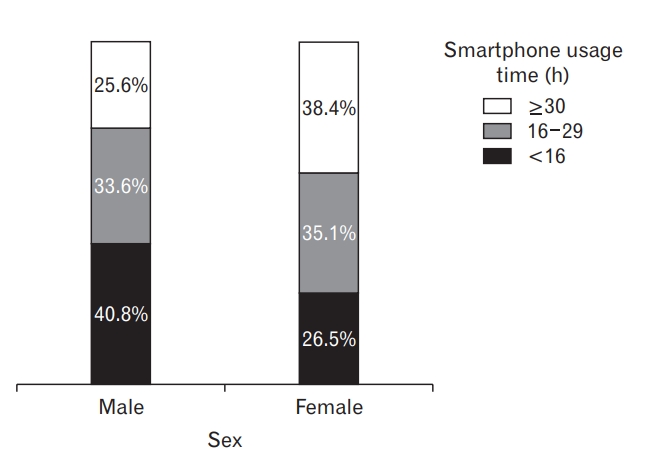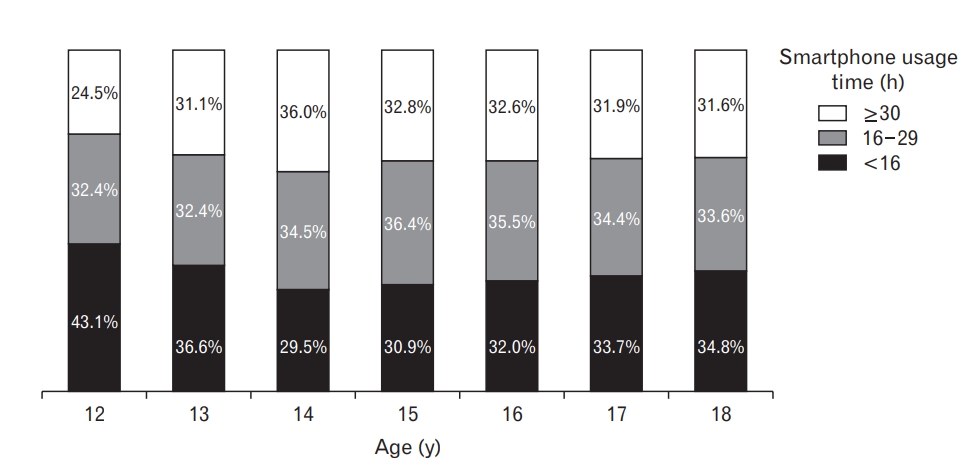 |
 |
- Search
| Korean J Fam Med > Volume 41(2); 2020 > Article |
|
Abstract
Background
Methods
Results
ACKNOWLEDGMENTS
SUPPLEMENTARY MATERIALS
Supplementary Table 1.
Table 1.
| Variable | Category | Overall |
Smartphone usage time per week |
P-value* | ||
|---|---|---|---|---|---|---|
| Low (<16 h) | Moderate (16–29 h) | High (≥30 h) | ||||
| No. of persons | 54,603 (100) | 18,338 (33.6) | 18,731 (34.3) | 17,534 (32.1) | ||
| Age (y) | 15.0±1.75 | 14.9±1.82 | 15.0±1.73 | 15.1±1.70 | <0.001 | |
| Sex | Male | 26,930 (50.6) | 11,001 (60.9) | 9,021 (49.3) | 6,908 (40.8) | <0.001 |
| Female | 27,673 (49.4) | 7,337 (39.1) | 9,710 (50.7) | 10,626 (59.2) | ||
| Economic status | High | 5,510 (10.3) | 2,534 (13.9) | 1,598 (8.7) | 1,378 (8.1) | <0.001 |
| Upper-middle | 16,009 (29.7) | 6,155 (34.2) | 5,525 (29.6) | 4,329 (24.8) | ||
| Middle | 25,297 (46.0) | 7,732 (41.7) | 9,016 (48.0) | 8,549 (48.5) | ||
| Low-middle | 6,453 (11.6) | 1,600 (8.6) | 2,209 (11.6) | 2,644 (15.0) | ||
| Low | 1,334 (2.4) | 317 (1.7) | 383 (2.1) | 634 (3.7) | ||
| Living apart from family | 87 (0.2) | 30 (0.1) | 20 (0.1) | 37 (0.2) | 0.254 | |
| Only child | 7,197 (13.3) | 2,669 (14.8) | 2,315 (12.4) | 2,213 (12.7) | <0.001 | |
| School violence experience | 1,186 (2.2) | 434 (2.3) | 323 (1.8) | 429 (2.5) | 0.652 | |
| Drinking experience | 21,897 (41.1) | 5,854 (33.0) | 7,372 (40.5) | 8,671 (50.6) | <0.001 | |
| Smoking experience | 7,124 (13.7) | 1,710 (9.9) | 2,244 (12.7) | 3,170 (18.9) | <0.001 | |
| Physical activity | High | 6,761 (13.1) | 2,439 (14.1) | 2,284 (12.7) | 2,038 (12.3) | <0.001 |
| Moderate | 14,882 (29.8) | 5,225 (31.5) | 5,131 (29.8) | 4,526 (27.9) | ||
| Low | 28,513 (57.2) | 9,005 (54.4) | 9,823 (57.5) | 9,685 (59.8) | ||
| School performance | High | 7,476 (13.5) | 3,726 (20.0) | 2,355 (12.2) | 1,395 (7.9) | <0.001 |
| Upper-middle | 14,437 (26.3) | 5,718 (31.4) | 5,177 (27.2) | 3,542 (19.6) | ||
| Middle | 15,707 (28.9) | 5,014 (27.7)) | 5,767 (31.1) | 4,926 (27.9) | ||
| Low-middle | 11,882 (21.8) | 2,859 (15.4) | 4,013 (21.7) | 5,010 (28.9) | ||
| Low | 5,101 (9.4) | 1,021 (5.5) | 1,419 (7.8) | 2,661 (15.7) | ||
| Problems caused by smartphone | ||||||
| Conflict with family members | 12,001 (22.3) | 3,200 (18.0) | 4,257 (23.0) | 4,544 (26.3) | <0.001 | |
| Conflict with peers | 1,899 (3.4) | 380 (2.0) | 574 (3.1) | 945 (5.4) | <0.001 | |
| Disturbance in school work | 13,473 (25.8) | 3,143 (18.2) | 5,112 (28.7) | 5,218 (31.2) | <0.001 | |
Table 2.
| Variable | Category | Overall |
Smartphone usage time per week |
P-value* | ||
|---|---|---|---|---|---|---|
| Low (<16 h) | Moderate (16–29 h) | High (≥30 h) | ||||
| Health condition | Very healthy | 14,771 (26.8) | 5,787 (31.2) | 4,821 (25.4) | 4,163 (23.4) | <0.001 |
| Healthy | 24,438 (44.7) | 8,271 (45.0) | 8,700 (46.3) | 7,467 (42.4) | ||
| Fair | 11,872 (22.0) | 3,372 (18.8) | 4,068 (22.0) | 4,432 (25.5) | ||
| Unhealthy | 3,280 (6.1) | 831 (4.6) | 1,083 (6.0) | 1,366 (8.0) | ||
| Very unhealthy | 242 (0.5) | 77 (0.4) | 59 (0.3) | 106 (0.7) | ||
| Sleep satisfaction | More than enough | 4,169 (7.3) | 1,736 (9.0) | 1,261 (6.5) | 1,172 (6.4) | <0.001 |
| Enough | 9,444 (16.8) | 3,598 (18.9) | 3,306 (16.9) | 2,540 (14.3) | ||
| Fair | 17,585 (32.3) | 5,674 (30.9) | 6,218 (33.2) | 5,693 (31.6) | ||
| Not enough | 15,663 (29.0) | 4,972 (27.9) | 5,461 (29.6) | 5,230 (31.9) | ||
| Not nearly enough | 7,742 (14.6) | 2,358 (13.3) | 2,485 (13.8) | 2,899 (36.1) | ||
| Stress level | No | 1,971 (3.6) | 884 (4.6) | 577 (3.0) | 510 (3.0) | <0.001 |
| Low | 8,917 (16.2) | 3,475 (18.5) | 3,086 (16.4) | 2,356 (13.3) | ||
| Middle | 23,129 (42.7) | 7,930 (43.8) | 8,202 (43.9) | 6,997 (40.2) | ||
| Upper-middle | 15,006 (27.5) | 4,514 (24.7) | 5,208 (28.0) | 5,284 (30.0) | ||
| High | 5,580 (10.1) | 1,535 (8.4) | 1,658 (8.7) | 2,387 (13.5) | ||
| Well-being | Very happy | 15,944 (28.5) | 6,203 (32.9) | 5,290 (27.5) | 4,451 (24.8) | <0.001 |
| Happy | 21,013 (38.6) | 7,049 (38.8) | 7,545 (40.3) | 6,419 (36.6) | ||
| Fair | 13,403 (25.1) | 3,900 (21.8) | 4,572 (25.1) | 4,391 (28.6) | ||
| Unhappy | 3,583 (6.6) | 981 (5.4) | 1,162 (6.2) | 1,440 (8.3) | ||
| Very unhappy | 660 (1.2) | 205 (1.2) | 162 (0.9) | 293 (1.7) | ||
| Depressive symptoms† | Yes | 13,850 (25.4) | 3,841 (21.0) | 4,526 (24.4) | 5,483 (31.3) | <0.001 |
| Suicidal thoughts† | Yes | 6,714 (12.2) | 1,793 (9.8) | 2,094 (11.1) | 2,827 (16.0) | <0.001 |
| Suicide attempts† | Yes | 2,108 (3.8) | 603 (3.3) | 608 (3.2) | 897 (5.1) | <0.001 |
† We defined depressive symptoms as having ever felt hopelessness or grief for more than 2 weeks that negatively affected daily living in the last year; suicidal thoughts as having ever thought about suicide in the last year; suicide attempts as having ever committed a suicide attempt in the last year.
Table 3.
| Smartphone usage time | Unadjusted | Model 1† | Model 2† | Model 3† | |
|---|---|---|---|---|---|
| Depressive symptoms | Low | 1 | 1 | 1 | 1 |
| Moderate | 1.14 (1.09–1.20) | 1.13 (1.07–1.19) | 1.07 (1.01–1.14) | 1.03 (0.97–1.10) | |
| High | 1.56 (1.41–1.65) | 1.52 (1.44–1.60) | 1.18 (1.10–1.26) | 1.13 (1.06–1.21) | |
| Ptrend‡ | <0.001 | <0.001 | <0.001 | <0.001 | |
| Suicidal thoughts | Low | 1 | 1 | 1 | 1 |
| Moderate | 1.10 (1.02–1.18) | 1.07 (1.00–1.15) | 1.03 (0.95–1.12) | 1.00 (0.92–1.09) | |
| High | 1.61 (1.50–1.73) | 1.52 (1.41–1.63) | 1.18 (1.08–1.29) | 1.14 (1.05–1.24) | |
| Ptrend‡ | <0.001 | <0.001 | <0.001 | 0.001 | |
| Suicide attempts | Low | 1 | 1 | 1 | 1 |
| Moderate | 1.12 (0.94–1.32) | 1.08 (0.91–1.28) | 0.97 (0.80–1.17) | 0.96 (0.79–1.17) | |
| High | 2.03 (1.72–2.39) | 1.90 (1.61–2.25) | 1.34 (1.11–1.60) | 1.32 (1.10–1.59) | |
| Ptrend‡ | <0.001 | <0.001 | <0.001 | <0.001 |
† In model 1, age, sex, economic status, and living apart from family were adjusted. Behavioral characteristics (school violence experience, drinking experience, smoking experience, physical activity, and self-reported health status [health condition, subjective well-being, stress, and sleep satisfaction]) were additionally adjusted in model 2. In model 3, problems caused by smartphone usage (conflict with family, conflict with peers, and disturbance in school work) were adjusted along with the covariates in model 2.









